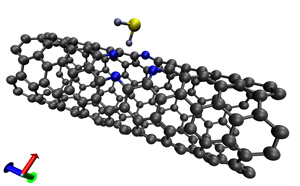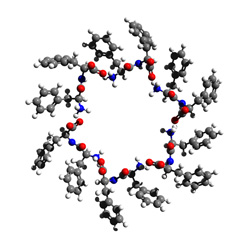
Research Projects
Our drive towards ever smaller, ever faster electronic devices is possibly leading us to the end of the silicon era. We are now entering the realm of nanoscience and technology where one is forced to look at the world from a completely different perspective. Systems as small as a dozen atoms could perform the same tasks that are today performed by sub-micrometer scale silicon-based devices. However, underlying mechanisms, at this length scales, is completely different. Thus, in the same way that nanoscale systems present tantalizing possibilities, they also present great challenges.
We believe carbon-based materials could be the underlying framework of tomorrow’s electronics. The many allotropic forms of carbon can be organized in variety of ways to suit the needs of a needed device/effect.
Within that class of materials one can find carbon nanotubes, graphene and graphene-nanoribbons, organic molecules, and last but not least biological molecules; such as DNA and petides.
Defective nanotubes
Defects in nanotubes can significantly alter their electronic and transport properties (as well as its mechanical properties). Such defects could be produced by ion irradiation and could be using for tailoring the electrical conductivity of multi-wall carbon nanotubes.
Here we study the electronic transport properties of double-wall carbon nanotubes with and without defects to infer the changes in the transmission coefficients of these devices. The main effect we are interested in is the influence of the links between the tubes on the transport.
Gas sensors

|
One of the possible applications of carbon nanotubes is in the field of sensors. The electronic transport properties of CNTs might be severely altered in the presence of a foreign species. Traditional simulations usually don’t take into consideration the fact that a realistic nanotube consists of binding sites which |
In this research topic we aim to combine the power of ab initio simulations with recursive Green’s function methods to atomistically simulate the properties of long one-dimensional sensors. Currently we are also interested in the same effect in bundles of nanotubes which could pave the way to simulating a real device and thus provide experimentalists with quantitative predictions.
Spintronics
Instead of using the charge of the electron, one might consider using another of its intrinsic properties, namely the spin. The so called field of spintronics started with the discovery of the giantmagnetoresistance effect in 1988 and has progressed to become a major research area in science.
|
Today we can envision the production of nanoscopic devices that can perform new and tantalizing tasks in this field. Carbon-based materials, due to the small spin-orbit coupling could be the perfect material for building such systems. Both small organic molecules and more recently graphene could be the underlying framework for spintronics devices. In this field e aim to study the electronic and transport properties of spintronics devices using a combination of out-of-equilibrium Green’s functions and density functional theory. We interested in effects such as GMR in molecules attached to magnetic electrodes as well as spin filtering effects. |

|
Peptide nanotubes

|
The potential medical applications of nanoscience and nanotechnology are a major driving force in the field’s research effort. Although carbon nanotubes present interesting properties, its toxicity prevents its widespread use in medicine. Thus, researchers have initiated a search for other one-dimensional systems that can be biologically compatible. In that aspect peptide nanotubes could provide us with a possible route. Its properties, including the effects of water In the structure, however, are little known. |
In this research project our aim is to determine, using a combination of ab initio density functional theory as well as tight-binding DFT, the electronic struture of peptide nanotubes in the presence of water. Most importantly, we are interested in the importance of the water molecules on the overall stability of the nanotube.


|
TranSim Research Group Centro de Ciências Naturais e Humanas - Universidade Federal do ABC Rua Catequese, 242 - Santo André - SP - 09090-400 - Brazil alexandre.rocha@ufabc.edu.br |

|







